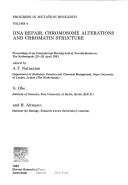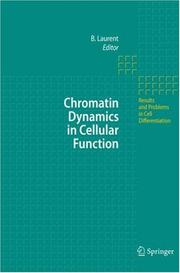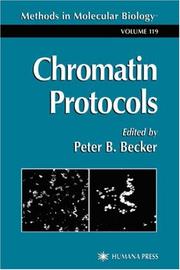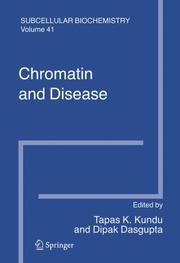| Listing 1 - 10 of 14 | << page >> |
Sort by
|

ISBN: 044480367X Year: 1982 Publisher: Amsterdam Elsevier biomedical
Abstract | Keywords | Export | Availability | Bookmark
 Loading...
Loading...Choose an application
- Reference Manager
- EndNote
- RefWorks (Direct export to RefWorks)
Chromatin --- Chromosome abnormalities --- DNA repair --- Chromatin --- Chromosome Aberrations --- DNA Repair --- Congresses --- Congresses --- Congresses
Book
ISBN: 0632005548 9780632005543 Year: 1981 Publisher: Oxford : Basil Blackwell,
Abstract | Keywords | Export | Availability | Bookmark
 Loading...
Loading...Choose an application
- Reference Manager
- EndNote
- RefWorks (Direct export to RefWorks)
Histology. Cytology --- Molecular biology --- Chromatin --- Chromosomes --- DNA. --- Chromatin. --- Chromosomes. --- Chromosome --- Chromatins --- ds-DNA --- DNA, Double-Stranded --- Deoxyribonucleic Acid --- DNA, Double Stranded --- Double-Stranded DNA --- ds DNA --- Biopolymers --- DNA --- GENES --- CELLS --- EUKARYOTIC CELLS --- CHROMATIN --- CHROMOSOMES --- BIOLOGICAL STUDIES

ISBN: 9783540336853 3540336850 3540336877 Year: 2006 Publisher: Berlin, Heidelberg : Springer Berlin Heidelberg : Imprint: Springer,
Abstract | Keywords | Export | Availability | Bookmark
 Loading...
Loading...Choose an application
- Reference Manager
- EndNote
- RefWorks (Direct export to RefWorks)
This volume includes timely reviews of several aspects of chromatin biology written by scientists at the forefront of this rapidly moving field. Topics covered include the structure and function of protein modules within chromatin-remodeling proteins, newly characterized histone modifications (methylation, ubiquitylation) and their functional consequences, transcription and histone dynamics, roles of chromatin remodeling factors in DNA replication and repair, and current models of nucleosome-remodeling mechanisms.
Chromatin Assembly and Disassembly. --- Cell Physiology. --- Histones. --- Chromatin. --- Chromatine --- Life sciences. --- Biochemistry. --- Cytology. --- Life Sciences. --- Cell Biology. --- Biochemistry, general. --- Chromatin --- Histones --- Chromatin Assembly and Disassembly --- Cell Physiological Phenomena --- DNA Packaging --- Gene Expression Regulation --- Nuclear Proteins --- Nucleoproteins --- Chromosome Structures --- Phenomena and Processes --- Proteins --- Genetic Structures --- Genetic Processes --- Cell Physiological Processes --- Chromosomes --- Amino Acids, Peptides, and Proteins --- Intranuclear Space --- Genetic Phenomena --- Chemicals and Drugs --- Cell Nucleus Structures --- Cell Nucleus --- Intracellular Space --- Cellular Structures --- Cells --- Anatomy --- Cytology --- Biology --- Health & Biological Sciences --- Biosciences --- Sciences, Life --- Anatomies --- Cell --- Cell Components --- Cell Component --- Cellular Structure --- Component, Cell --- Components, Cell --- Structure, Cellular --- Structures, Cellular --- Cell Nuclei --- Nuclei, Cell --- Nucleus, Cell --- Cell Nucleus Structure --- Structure, Cell Nucleus --- Structures, Cell Nucleus --- Genetic Concepts --- Genetic Phenomenon --- Genetic Process --- Concept, Genetic --- Concepts, Genetic --- Genetic Concept --- Phenomena, Genetic --- Phenomenon, Genetic --- Process, Genetic --- Processes, Genetic --- Chromosome --- Cell Physiological Phenomenon --- Cell Physiological Process --- Physiology, Cell --- Cell Physiology --- Phenomena, Cell Physiological --- Phenomenon, Cell Physiological --- Physiological Process, Cell --- Physiological Processes, Cell --- Process, Cell Physiological --- Processes, Cell Physiological --- Genetic Structure --- Structure, Genetic --- Structures, Genetic --- Gene Products, Protein --- Gene Proteins --- Protein Gene Products --- Proteins, Gene --- Chromosome Structure --- Structure, Chromosome --- Structures, Chromosome --- Nucleoprotein --- Nuclear Protein --- Nucleolar Proteins --- Protein, Nuclear --- Proteins, Nuclear --- Proteins, Nucleolar --- Expression Regulation, Gene --- Regulation, Gene Action --- Regulation, Gene Expression --- Gene Action Regulation --- Regulation of Gene Expression --- Packaging, DNA --- Chromatin Assembly --- Chromatin Disassembly --- Chromatin Modeling --- Chromatin Remodeling --- Chromatin Disassemblies --- Disassembly, Chromatin --- Remodeling, Chromatin --- Chromatins --- Histone --- Histone H1 --- Histone H1(s) --- Histone H2a --- Histone H2b --- Histone H3 --- Histone H3.3 --- Histone H4 --- Histone H5 --- Histone H7 --- Cell biology --- Cellular biology --- Biological chemistry --- Chemical composition of organisms --- Organisms --- Physiological chemistry --- physiology --- Composition --- Subcellular Space --- Intracellular Spaces --- Space, Intracellular --- Space, Subcellular --- Spaces, Intracellular --- Spaces, Subcellular --- Subcellular Spaces --- Subnuclear Space --- Intranuclear Spaces --- Space, Intranuclear --- Space, Subnuclear --- Spaces, Intranuclear --- Spaces, Subnuclear --- Subnuclear Spaces --- Cell biology. --- Cytologists --- Chemistry --- Medical sciences

ISBN: 0896036650 9786610831562 1280831561 1592596819 Year: 1999 Volume: 119 Publisher: Totowa, NJ : Humana Press : Imprint: Humana,
Abstract | Keywords | Export | Availability | Bookmark
 Loading...
Loading...Choose an application
- Reference Manager
- EndNote
- RefWorks (Direct export to RefWorks)
More than 40 years after the discovery of the nucleosome as the fun- mental unit of chromatin, the multifaceted problem of how variations in ch- matin structure affect the activity of the eukaryotic genome has not been solved. However, during the past few years research on chromatin structure and fu- tion has gained considerable momentum, and impressive progress has been made at the level of concept development as well as filling in crucial detail. The structure of the nucleosome has been visualized at unprecedented reso- tion. Powerful multisubunit enzymes have been identified that alter histone/ DNA interactions in ways that expose regulatory sequences to factors initi- ing and regulating such nuclear processes as transcription. Though the imp- tance of posttranslational modifications of histones, notably their acetylation, has long been known, the finding that a number of bona fide regulators increase transcription by acetylating nucleosomes has lent new support to the old idea that the process of gene regulation is intimately related to the nature of the chromatin environment. A wealth of nonhistone proteins contribute to a continuum of structures with distinct biochemical properties and varying degrees of DNA condensation. Perhaps the most important conclusion from a large number of studies is a fresh appreciation of the dynamic nature of chromatin structure, the built-in flexibility providing the basis for regulation.
Chromatin --- Chromatine --- Laboratory manuals. --- Manuels de laboratoire --- Chromatin -- Laboratory manuals. --- Chromosomes. --- Electronic books. -- local. --- Biology --- Health & Biological Sciences --- Cytology --- Chromosome theory --- Cell nuclei --- Crossing over (Genetics) --- Cytotaxonomy --- Genetics --- Karyokinesis --- Linkage (Genetics) --- Chromosomes --- Nucleoproteins --- Cytology. --- Cell Biology. --- Cell biology --- Cellular biology --- Cells --- Cytologists
Periodical
Abstract | Keywords | Export | Availability | Bookmark
 Loading...
Loading...Choose an application
- Reference Manager
- EndNote
- RefWorks (Direct export to RefWorks)
Epigenesis, Genetic --- Chromatin --- Epigenesis --- Epigénèse --- Chromatine --- genetics --- Periodicals. --- Périodiques --- Epigenesis, Genetic. --- Chromatin. --- Epigenesis. --- genetics. --- Epigenetic Process --- Epigenetics Processes --- Epigenetic Processes --- Genetic Epigenesis --- Process, Epigenetic --- Processes, Epigenetic --- Processes, Epigenetics --- epigenetic inheritance --- Embryology --- Evolution (Biology) --- Genetics --- Chromosomes --- Nucleoproteins --- DNA Methylation --- Genetics & Genomics. --- Epigenome --- Animal Anatomy & Embryology
Book
ISBN: 3030686701 3030686698 Year: 2021 Publisher: Springer Nature
Abstract | Keywords | Export | Availability | Bookmark
 Loading...
Loading...Choose an application
- Reference Manager
- EndNote
- RefWorks (Direct export to RefWorks)
This open access textbook leads the reader from basic concepts of chromatin structure and function and RNA mechanisms to the understanding of epigenetics, imprinting, regeneration and reprogramming. The textbook treats epigenetic phenomena in animals, as well as plants. Written by four internationally known experts and senior lecturers in this field, it provides a valuable tool for Master- and PhD- students who need to comprehend the principles of epigenetics, or wish to gain a deeper knowledge in this field. After reading this book, the student will: Have an understanding of the basic toolbox of epigenetic regulation; Know how genetic and epigenetic information layers are interconnected; Be able to explain complex epigenetic phenomena by understanding the structures and principles of the underlying molecular mechanisms; Understand how misregulated epigenetic mechanisms can lead to disease.
Epigenetics. --- Genetic regulation. --- Molecular genetics. --- Genetics --- Molecular biology --- Gene expression --- Gene expression regulation --- Gene regulation --- Biosynthesis --- Cellular control mechanisms --- Molecular genetics --- Regulation --- Genetics and Genomics --- Biomedicine, general --- Cell Biology --- Human Genetics --- Epigenetics --- Biomedical Research --- Medical Genetics --- Cancer --- Chromatin --- Chromatin Dynamics --- Cellular Memory --- DNA Methylation --- Epigenetic Textbook --- Gene Regulation --- Gene Silencing --- Histone Modification --- Imprinting --- Inheritance --- Metabolism --- Nucleus --- Open Access --- Pluripotency --- Reprogramming --- RNA Mechanisms --- Transcription --- X Chromosome inactivation --- Genetics (non-medical) --- Medical research --- Cellular biology (cytology) --- Epigenètica
Book
ISBN: 1402095600 9786612019463 1282019465 1402095619 Year: 2009 Publisher: Dordrecht : Springer Netherlands : Imprint: Springer,
Abstract | Keywords | Export | Availability | Bookmark
 Loading...
Loading...Choose an application
- Reference Manager
- EndNote
- RefWorks (Direct export to RefWorks)
The Greek word apoptosis was used first by Hippocrates as a synonyme of dislocations of the bones, structural changes related to tissue, by Marcus Aurelius in political and social context as failure and decline. The physician Galen extended the medical meaning of apoptosis to wound healing and inflammation. Apoptosis, or cell suicide is an integral part of life cycle of plants and animals indicated by the loss of 140-190g (50-70 billion) cells each day in the human adult, amounting to the body weight in one year. The growing interest in apoptosis is indicated by the number of scientific publications since the 1990s which is now more than 140,000 and will exceed 160,000 by the end of 2008. The unique feature of this book is the use of synhronized and reversibly permeabilized cells allowing to visualize the dynamic nature of chromatin condensation through transitory chromatin and chromosomal forms including changes upon genotoxic treatment, which were not seen earlier. The chromatin condensation process is illustrated from string (DNA) to rope (chromosomes) in more than 160 figures. The interdisciplinary nature of studies summarized in the book facilitate the global view of readers interested in the higher order structure of nucleic acids. The wealth of additional information will attract a wide population of readers. The natural audience engaged in DNA research such as genetics, cell biology, biochemistry, molecular biology will find that it contains essential material.
Apoptosis. --- Chromatin. --- Apoptosis --- Chromatin --- Nucleoproteins --- Chromosome Structures --- Cell Death --- Genetic Structures --- Proteins --- Chromosomes --- Cell Physiological Processes --- Intranuclear Space --- Amino Acids, Peptides, and Proteins --- Cell Physiological Phenomena --- Genetic Phenomena --- Cell Nucleus Structures --- Chemicals and Drugs --- Phenomena and Processes --- Cell Nucleus --- Intracellular Space --- Cellular Structures --- Cells --- Anatomy --- Biology --- Biology - General --- Cytology --- Health & Biological Sciences --- DNA --- Research. --- Deoxyribonucleic acid --- Desoxyribonucleic acid --- Thymonucleic acid --- TNA (Nucleic acid) --- Medicine. --- Cancer research. --- Oncology. --- Cell biology. --- Microscopy. --- Biomedicine. --- Cancer Research. --- Cell Biology. --- Biological Microscopy. --- Deoxyribose --- Nucleic acids --- Genes --- Cell death --- Oncology . --- Cytology. --- Analysis, Microscopic --- Light microscopy --- Micrographic analysis --- Microscope and microscopy --- Microscopic analysis --- Optical microscopy --- Optics --- Tumors --- Cell biology --- Cellular biology --- Cytologists --- Cancer research

ISBN: 128086530X 9786610865307 1402054661 1402054653 9048173744 Year: 2007 Publisher: Dordrecht : Springer Netherlands : Imprint: Springer,
Abstract | Keywords | Export | Availability | Bookmark
 Loading...
Loading...Choose an application
- Reference Manager
- EndNote
- RefWorks (Direct export to RefWorks)
It is more evident now than ever before that dynamic organization of human genome into nucleoprotein structure, chromatin confers the unique regulatory mechanisms for most of the cellular phenomena, which include replication, transcription, DNA repair, recombination and also apoptosis. The dynamic nature of the chromatin is regulated by chromatin modifications (epigenetic alterations), remodeling, histone chaperones and functional interactions of different chromatin interacting n- histone proteins. Dysfunction of this highly inter connected machineries disturb the cellular homoeostasis, and thereby causes several diseases. As we advance in our knowledge of chromatin function and also disease mechanisms in more details, their causal relationship is becoming more evident. This has lead to the identification of chromatin function as target for new generation therapeutics. In the light of these advances, it happens to be the right time to explore current insights into various aspect of chromatin and disease connection under one cover. Authors who are actively involved in chromatin research and have made several original contributions to develop latest paradigms in the field have written the chapters of this book. Significantly, the authors’ repertoire is truly international. They come from eight different countries of Asia, Europe and America. The book has been divided into three different parts. Part I introduces the reader to the dynamic nature of chromatin structure and its link to diseases. First two chapters in this part deal with the chromatin architecture, chromatin dynamics in the cell cycle and molecular mechanism of chromatin remodeling.
Chromatin. --- Epigenesis. --- Drug targeting. --- Drugs --- Site-specific drug delivery --- Targeting of drugs --- Target organs (Anatomy) --- Embryology --- Evolution (Biology) --- Genetics --- Chromosomes --- Nucleoproteins --- Targeting --- Dosage forms --- Biochemistry. --- Microbiology. --- Medical virology. --- Biochemistry, general. --- Medical Microbiology. --- Virology. --- Medical microbiology --- Virology --- Virus diseases --- Microbial biology --- Biology --- Microorganisms --- Biological chemistry --- Chemical composition of organisms --- Organisms --- Physiological chemistry --- Chemistry --- Medical sciences --- Composition --- Medical microbiology. --- Microbiology
Book
ISBN: 0306408864 146847958X 1468479563 Year: 1981 Volume: vol 40 Publisher: New York, NY : Plenum Press,
Abstract | Keywords | Export | Availability | Bookmark
 Loading...
Loading...Choose an application
- Reference Manager
- EndNote
- RefWorks (Direct export to RefWorks)
Chromosome replication --- -DNA repair --- -Mutagenesis --- -Mutation (Biology) --- Radiogenetics --- Teratogenesis --- Deoxyribonucleic acid repair --- Repair, DNA --- Repair mechanisms in DNA --- Biochemical genetics --- Antimutagens --- Replication of chromosomes --- Cell division --- DNA replication --- Congresses --- -Congresses --- DNA repair --- Mutagenesis --- CARCINOGENS --- CHROMOSOMES --- DNA --- CHROMATIN --- ALKYLATING AGENTS --- MUTAGENS --- BIOLOGICAL STUDIES
Book
ISBN: 1402091869 9786611920449 1281920444 1402091877 9400789548 Year: 2009 Publisher: Dordrecht : Springer Netherlands : Imprint: Springer,
Abstract | Keywords | Export | Availability | Bookmark
 Loading...
Loading...Choose an application
- Reference Manager
- EndNote
- RefWorks (Direct export to RefWorks)
Epigenetic modifications act on DNA and its packaging proteins, the histones, to regulate genome function. Manifest as the heritable methylation of DNA and as post-translational histone modifications, these molecular flags influence the architecture and integrity of the chromosome, the accessibility of DNA to gene regulatory components and the ability of chromatin to interact within nuclear complexes. While a multicellular individual has only one genome, it has multiple epigenomes reflecting the diversity of cell types and their properties at different times of life; in health and in disease. Relationships are emerging between the underlying DNA sequence and dynamic epigenetic states and their consequences,such as the role of RNA interference and non-coding RNA. These integrated approaches go hand-in-hand with studies describing the genomic locations of epigenetic modifications in different cell types at different times. The excitement and curiosity surrounding epigenomics is driven by a growing community of researchers in a burgeoning field and the development of new technologies built on the backbone of genome sequencing projects. Research has shown that the adaptability and vulnerability of epigenetic states has profound effects on natural variation, the response of the genome to its environment and on health and disease. The aim of this volume is not to describe epigenomes, but rather to explore how understanding epigenomes tells us more about how biological systems work and the challenges and approaches taken to accomplish this. These contributions have attempted to integrate epigenomics into our understanding of genomes in wider context, and to communicate some of the wonders of epigenetics illustrated through examples across the biological spectrum.
Medicine. --- Epigenesis --- Genomics --- Chromatin --- DNA --- Animal Anatomy & Embryology --- Cytology --- Zoology --- Biology --- Health & Biological Sciences --- Epigenesis. --- Genomics. --- Genome research --- Genomes --- Research --- Biomedicine. --- Biomedicine general. --- Molecular genetics --- Embryology --- Evolution (Biology) --- Genetics --- Clinical sciences --- Medical profession --- Human biology --- Life sciences --- Medical sciences --- Pathology --- Physicians --- Health Workforce --- Biomedicine, general.
| Listing 1 - 10 of 14 | << page >> |
Sort by
|

 Search
Search Feedback
Feedback About
About Help
Help News
News